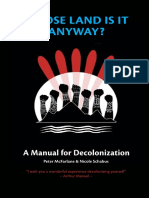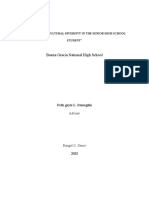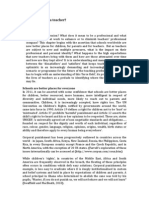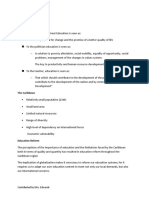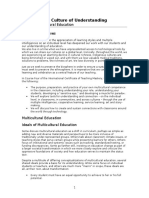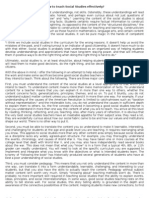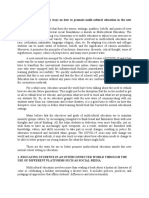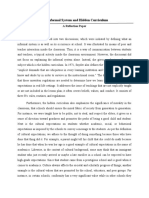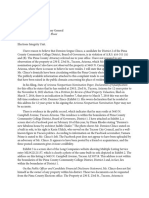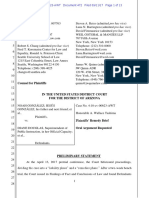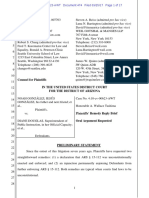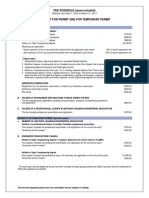TUSD White Paper
TUSD White Paper
Uploaded by
DA MoralesCopyright:
TUSD White Paper
TUSD White Paper
Uploaded by
DA MoralesCopyright
Share this document
Did you find this document useful?
Is this content inappropriate?
Copyright:
TUSD White Paper
TUSD White Paper
Uploaded by
DA MoralesCopyright:
White Paper Tucson Unified School District's Civil Rights Imperative: Equity, Cultural Responsiveness, Critical Multicultural Education,
and the Achievement of Equality in Academic Outcomes for All Students Context Tucson Unified School District (TUSD) is currently in the middle of its second attempt to obtain unitary status in its federal desegregation case. i This latest attempt has acknowledged the need to address the academic outcomes of the represented plaintiff groups. Moreover, TUSD recognizes the need to address this issue from an equity-based perspective that is culturally responsive. Belaboring the historic gap in academic performance of our historically underserved students or blaming their families ii or their socio-economic statusiii or their culture has not proven itself helpful in the implementation of actions that reverse the academic trajectory of these students. Reviewing data or even using data to name the problem(s) is not enough. The historic and contemporary underachievement of our historically underserved students has been the focus of conversation for decades; iv however, the divergent trajectory between historically underserved students and their White peers continues. v Whether we like it or not race and ethnicity are still the dominant explanatory and/or predictive variables in the academic achievement equation. TUSD must gain an understanding of how to make schools more effective and joyous places for all students; especially, those who have been historically underserved. Therefore, we must redefine who we are. As we define our new identity, we must have the courage to look in the mirror; we must be honest about what we see or do not see in the mirror; and in some cases we must acknowledge that we may not understand what we see and/or what we do not see. Our new identity affects the identity that our students will form; especially, our historically underserved students because it becomes what we do in their service. We must acknowledge our historic failure to equitably and effectively help our underserved students develop a strong academic identity. Identity formation is critical to the academic success of our students; vi moreover, the nurturing of an academic identity is hyper critical to the academic success of our students; in particular, students from historically underserved populations. vii Gay articulates how an adverse educational experience impacts the identities of both students and teachers. In her example, Gay uses a well meaning inspirational small business motto: "Failure is an experience, not an individual. viii Regrettably, this is untrue for many students who are unsuccessful in school. They and their teachers connect their academic difficulties to their personal worth, and the individuals are deemed failures." ix
White Paper: Cultural Responsive Pedagogy - DMC A. F. Romero, Ph. D.
Page 1
A New Trajectory: Student Equity In order to shift our trajectory, we must forgo the notion of "at-risk" students, and focus on the greatest variable in the achievement gap equation, which is a "system that creates risk." x William Ryan helps us understand that our achievement gaps are not a product of our students, their parents, their communities or their culture: We are dealing; it would seem, not so much with the culturally deprived children as with culturally depriving schools. And the task to be accomplished is not to revise, amend, and repair deficient children, but to alter and transform the atmosphere and operations of the schools to which we commit the children. xi Academic success and the equality of academic outcome for our historically underserved students are possible. The success of these students is dependent upon our will to create the most equitable academic and social condition possible. The initial steps and understanding of this bold, just, and equitable endeavor are outlined below. What is step one? Step one is to examine the issues, biases and prejudices that are carried into our classrooms, our schools, central offices, boardrooms etc., and how these things impact curricula, pedagogy, policies and actions. xii We must constantly engage in a process of examining, reexamining and critiquing our own perspective because these steps or failure to engage these steps affect the way we approach transformation, and will directly impact the level of success our students will experience. Why is traditional curricular and pedagogical transformation necessary? For many people, it is easy and convenient to forget that the United States' public school system has an overtly racist and classist history. xiii As we examine our shortcomings within this historical context, it is important to remember that the FisherMendoza desegregation challenge to the overtly discriminatory educational practices in our District did not and has not addressed the issue of academic achievement. Placing the issue of academic outcomes in our Unitary Status Plan creates a new space (a new TUSD identity), a space wherein not only must we acknowledge, name and define the district's discriminatory reality; moreover, we must create solutions that remedy these academic and civil rights issues. The curriculum has been and is Eurocentric ignoring the historical narratives, perspectives, literature, and accomplishments of our underserved and underrecognized students groups. While to some extent conditions have improved, an equity gap in our system remains; therefore, allowing for the perpetuation and preservation of TUSD's discriminatory history. TUSD can no longer ignore the failures of our traditional pedagogical and curricular methodologies and implementations. In order to achieve excellence we must become truly equitable in all of our approaches, practices, and policies. At the core of our new identity must exist: integrity, honesty, equity, and justice. This would provide our White Paper: Cultural Responsive Pedagogy - DMC A. F. Romero, Ph. D. Page 2
historically underserved students with the opportunity to finally receive the equitable and excellent education experience they truly deserve. What are the fundamental values of a culturally responsive curriculum? The fundamental values of a culturally responsive curriculum are the same as any good curriculum: accuracy, completeness, and inclusion. However, we can no longer ignore the importance of social and cultural relevance as a critical element of these values. These fundamental values become reality only when the curriculum represents a full picture of a given topic. Do we present various sources and perspectives, and do we include counter-narratives xiv that are more relevant and meaningful to our historically underserved students? We must challenge ourselves to create and deliver curricula that are accurate, complete, inclusive and culturally responsive. Theoretical Stages of Culturally Responsive Transformation There are several theoretical stages to culturally responsive curricular transformation. The stages range from slight curricular changes to a fully-revised social awareness and action conceptualizations. These theoretical stages are: Contributions Approach, Ethnic Additive Approach, Transformation Approach and Decision-Making and Social Action Approach. xv Contributions Approach The Contributions Approach is the easiest stage to integrate. In this stage ethnic and/or cultural content is limited to special days, weeks or months and focuses on certain heroes and some holidays. The teaching of ethnic or cultural issues with the use of heroes and holidays tends to gloss over important concepts and issues related to struggles against racism and for power, while trivializing ethnic cultures as a study of their eccentric and exotic characteristics, thus fortifying stereotypes and misconceptions. When the primary focus is the contributions approach, students are not helped to understand these cultural and/or ethnic groups as complete and dynamic wholes, and therefore these cultures or ethnic groups are othered xvi or given less societal and/or cultural value. Ethnic Additive Approach The Additive Approach implements cultural and/or ethnic content, concepts, themes, and perspectives to the curriculum without changing its basic structure, purposes, and characteristics. This approach is achieved by the addition of a book or unit to a course without changing it substantially. This stage is limited because of the othering effect that fails to help students to view society from diverse cultural and ethnic perspectives and to understand the ways in which the histories and cultures of the nation's diverse ethnic, racial, cultural, and religious groups are inextricably bound.
White Paper: Cultural Responsive Pedagogy - DMC A. F. Romero, Ph. D.
Page 3
Transformation Approach The Transformation Approach differs fundamentally from the Contributions and Additive Approaches because it requires students to view concepts, issues, themes, and problems from several ethnic perspectives and points of view. For our historically underserved students, this presents them with the opportunity to not only research, explore and intellectualize their social, cultural, and historical experiences and perspectives; most important, these experiences and perspectives are given the same cultural and curricular capital as the traditional narrative. This infusion extends student understandings of the nature, development, and complexity of U.S. society and how these convergent and even divergent perspectives and experiences have created this nation. This approach brings us closer to the delivery of curricula that is more inclusive, meaningful, accurate, holistic, and truthful. Decision-Making and Social Action Approach This stage builds onto the elements of the Transformation Approach by requiring students to make decisions and to take actions on issues related to their social condition. In this student-research based approach students name the problem, gather pertinent data, analyze their data, reexamine and rethink their ideologies and values, and create an alternative plan of action, and finally decide what, if any, actions they take will remedy the issue, if so students implement the plan. Major goals of this approach are to intellectualize students, develop their decision making capacities, to empower them, and to help them acquire a sense of civic and community responsibility and ownership. Implications In developing and implementing our culturally responsive pedagogy and curricula - we must clearly recognize and acknowledge that education is not society's panacea. However, the critically transformative endeavor upon which we embark, offers our students, our parents, our teachers, our district, and our communities a critical imperative doorway to hope. One hope offered by this transformation is simple - that in these times of: Orwellian realism, the attack on the middle class, the perpetuation of privilege, shrinking education budgets, and the attacks on public education - this transformative initiative based on inclusiveness, wholeness, accuracy, equality, and equity can still somehow against all odds make a difference.
White Paper: Cultural Responsive Pedagogy - DMC A. F. Romero, Ph. D.
Page 4
June1978 U.S. District Judge William Frey issues a 223-page ruling that orders TUSD to eliminate all vestiges of discrimination. 2009 U.S. District Judge
ii
Terman, L. (1916). The measurement of intelligence: An explanation of and a complete Guide for theuseof the Stanford revision and extension of the Benet-Simon intelligence scale. Boston: Houghton Mifflin. Lewis, 0. (1965).Five families: Mexican case study in the culture of poverty. New York: New American Liberty. Payne, R. (2003). A framework for understanding poverty. Highlands, TX: Aha! Process Ferguson, R. (2000). What doesn't meet theeye: Understanding and addressing racial disparities in highachieving suburban schools. Cambridge, MA: Harvard. Kober, N. (2001). It takes more than testing: Closing the achievement gap. Center on Education Policy. Retrieved from www.ctredpol.org/improvingpublicschools. National Center for Education Statistics(2001). Educational achievement and black-white inequality (pp. 31-43) .U.S. Department of Education. Retrieved from http://nces.ed.gov/pubsearch/pubsinfo.asp7pubids2001061. National Center for Education Statistics. (2008). Average reading scores for Whites, Blacks and Hispanics 9 years old higher in 2008 than all previous assessments. In The Nation's Report Card, Long-term trends. Retrieved August 10, 2012, from http://nationsreportcard.gov/ltt_2008/ltt0009.asp?subtab_id=Tab_id=tab#chart). Olszewski-Kubilius, P., S. Lee, M. Ngoi, and D. Ngoi. (2004). Addressing the achievement gap between minority and nonminority children by increasing access to gifted programs. Journal for the Education of the Gifted 28(2): 127-58.
iii iv
Coley, J. (2003). Growth in school revisited: Achievement gains from the Seventh to eighth grade. Princeton, NJ: Educational Testing Service. Eijkman, H. (2003b). Reframing the first-year experience: The critical role of "recognition work" in achieving curricular justice. UltiBASE. http://ultibase.rmit.edu.au/. Oyserman, D.,Altschul, I.&Bybee, D. (2006). Racial ethnic identity in mid -adolescence: Content and change as predictors of academic achievement. Child Development, 77 (5), 1155-1169. Fuligni, A.,Witkow, M. &. Garcia, C. (2005). Ethnic identity and the academic adjustment of adolescents from Mexican, Chinese, and European backgrounds. Developmental Psychology, 41 (5), 799-811.
vii vi
Romero, A. (2008). Towards a critically compassionate intellectualism model of transformative education: Love, hope, identity, and organic intellectualism through the convergence of critical race theory, critical pedagogy, and authentic caring. Unpublished doctoral dissertation, University of Arizona. Gay, G. (2010). Culturally responsive teaching: Theory, research, and practice. Teachers College Press: New York. Ibid
viii
ix x
Ryan, W. (1972). Blaming the Victim. New York: Vintage Books. Romero, A. (2008). Spring. J (2008). The American school: From the Puritans to no child left behind. New York: McGraw-Hill Higher Education. Ibid.
xi xii
Hawley, H. & Nieto, S. (2010). Another inconvenient truth: Race and ethnicity matter. Educational Leadership, 68(3): 66-71.
xiii xiv
Spring, 2008.
Narratives that go beyond the traditional or Eurocentric narratives (See Yosso, T. 2006. Critical race counterstories along the Chicana/Chicano educational pipeline. New York: Routledge).
xv xvi
Banks, J. (1994). Multiethnic Education: Theory and practice. Boston: Allyn and Bacon.
The processes that identify those who are thought to be different from oneself or the mainstream; whereby, these thoughts can then reinforce, reproduce or produce positions of domination and subordination (see Johnson et al, 2004. Othering and being othered in the context of health care services. Health Commun, 16(2): 255-71.
White Paper: Cultural Responsive Pedagogy - DMC A. F. Romero, Ph. D.
Page 5
You might also like
- Affirming Diversity Ch. 1Document39 pagesAffirming Diversity Ch. 1Stephanie Abraham83% (6)
- The Development of The Social and Academic Identities of International Students in English Speaking Higher Education InstitutionsDocument23 pagesThe Development of The Social and Academic Identities of International Students in English Speaking Higher Education InstitutionsDita Noor Fitriani50% (2)
- Form 2 Lesson Plan Cefr 2018mutiara13Document2 pagesForm 2 Lesson Plan Cefr 2018mutiara13meiphengchanNo ratings yet
- Decolonization HandbookDocument79 pagesDecolonization HandbookDA Morales100% (1)
- MBA540 SyllabusDocument9 pagesMBA540 SyllabusDalila MelendezNo ratings yet
- RA 5527 and Its AmendmentsDocument7 pagesRA 5527 and Its AmendmentsCatherine MerillenoNo ratings yet
- Current Approaches To Moral EducationDocument23 pagesCurrent Approaches To Moral Educationcvanaidu100% (1)
- MIDTERMSDocument22 pagesMIDTERMSKaren Ardina ManggaoNo ratings yet
- Social Exclusion and Inclusion of WomenDocument10 pagesSocial Exclusion and Inclusion of WomenleoniNo ratings yet
- Chapter 1-3 - RangelDocument17 pagesChapter 1-3 - Rangelraisy jane senocNo ratings yet
- Msoe 01Document7 pagesMsoe 01AakashMalhotraNo ratings yet
- Diversity, Multiculturalism, Gender, and Exceptionality in The SocStud ClassroomDocument43 pagesDiversity, Multiculturalism, Gender, and Exceptionality in The SocStud ClassroomJazel May PonteNo ratings yet
- Deconstructing Power Privilege and SilenDocument18 pagesDeconstructing Power Privilege and SilenPj InudomNo ratings yet
- MulticulturalDocument3 pagesMulticulturalPrincess Priah FerrerNo ratings yet
- Action Research 350phpDocument4 pagesAction Research 350phpstudentschoicebusinessacadNo ratings yet
- Historical Foundation of EducationDocument31 pagesHistorical Foundation of EducationSHERYL ABUELNo ratings yet
- Hill Capstone Lo5 2Document4 pagesHill Capstone Lo5 2api-544194766No ratings yet
- My Narrative Report Feb 2024Document3 pagesMy Narrative Report Feb 2024Charmagne BorraNo ratings yet
- Culturally Responsive Final PaperDocument7 pagesCulturally Responsive Final Paperirenealarcon7No ratings yet
- The Black Socio-Cultural Cognitive Learning Style HandbookFrom EverandThe Black Socio-Cultural Cognitive Learning Style HandbookNo ratings yet
- What Is Social StudiesDocument3 pagesWhat Is Social Studiesapi-321465260No ratings yet
- Morgan Bevell 807 Reflection2Document3 pagesMorgan Bevell 807 Reflection2api-611338134No ratings yet
- Tedesco - Curriculum DebateDocument20 pagesTedesco - Curriculum DebateJ Khedrup R TaskerNo ratings yet
- Education ResearchDocument2 pagesEducation Researchflorie.vhel2003No ratings yet
- Cultural Patterns in Urban Schools: A Manual for Teachers, Counselors, and AdministratorsFrom EverandCultural Patterns in Urban Schools: A Manual for Teachers, Counselors, and AdministratorsNo ratings yet
- Imposed Identities and British Further Education: The Experiences of Learners Classified as "Low Ability"From EverandImposed Identities and British Further Education: The Experiences of Learners Classified as "Low Ability"No ratings yet
- Cultural Foundations - Kent State UniversityDocument3 pagesCultural Foundations - Kent State UniversitycarloslopezmxNo ratings yet
- What Is Culturally Responsive TeachingDocument10 pagesWhat Is Culturally Responsive TeachingKaviyasan Udayakumar100% (1)
- DiversityDocument81 pagesDiversityNanthiniNo ratings yet
- Reflective JournalDocument4 pagesReflective JournalJustyn GwynNo ratings yet
- SCC 1 3Document72 pagesSCC 1 3memeadomamo10No ratings yet
- Teacher Education and Social ChangeDocument5 pagesTeacher Education and Social ChangeGnabryNo ratings yet
- Concept NoteDocument3 pagesConcept NoteYatin BehlNo ratings yet
- Diversity ReflectionDocument6 pagesDiversity Reflectionapi-321351703No ratings yet
- How To Be A Teacher - Chapter 1Document15 pagesHow To Be A Teacher - Chapter 1Pato PetersNo ratings yet
- Diversity BriefDocument16 pagesDiversity Briefapi-253748903No ratings yet
- Developing Resilient Youth: Classroom Activities for Social-Emotional CompetenceFrom EverandDeveloping Resilient Youth: Classroom Activities for Social-Emotional CompetenceNo ratings yet
- Lect. 6.2 Caribbean EducationDocument8 pagesLect. 6.2 Caribbean EducationToriNo ratings yet
- CH 9 P1 History of Literacy EducationDocument6 pagesCH 9 P1 History of Literacy EducationSardar HusseinNo ratings yet
- Critical Pedagogy and Teacher Education - BartolomeDocument26 pagesCritical Pedagogy and Teacher Education - BartolomeAbu UbaidahNo ratings yet
- 11,12 - Inequalities in Education - Education and DevelopmentDocument12 pages11,12 - Inequalities in Education - Education and DevelopmentZeeshan ZamirNo ratings yet
- Diversity QuestionsDocument4 pagesDiversity QuestionsKevin FajardoNo ratings yet
- Essay 1st 40 PagesDocument53 pagesEssay 1st 40 PagesstudentschoicebusinessacadNo ratings yet
- Ethno-Centric HandoutDocument4 pagesEthno-Centric Handoutapi-318154963No ratings yet
- The What Why and How of Culturally Responsive Teaching International Mandates Challenges and OpportunitiesDocument18 pagesThe What Why and How of Culturally Responsive Teaching International Mandates Challenges and Opportunitiesapi-696560926No ratings yet
- Culturally Responsive PedagogyDocument8 pagesCulturally Responsive Pedagogyapi-275322444No ratings yet
- Social Foundations of EducationDocument16 pagesSocial Foundations of EducationAbbas SafiNo ratings yet
- Teaching To and Through Cutural Diversity PDFDocument23 pagesTeaching To and Through Cutural Diversity PDFYarella EspinozaNo ratings yet
- A Framework For Culturally Responsive Teaching: Motivation Is Inseparable From CultureDocument7 pagesA Framework For Culturally Responsive Teaching: Motivation Is Inseparable From CulturenainisNo ratings yet
- Identity Community and Diversity Retheorizing Multicultural Curriculum For The Postmodern EraDocument13 pagesIdentity Community and Diversity Retheorizing Multicultural Curriculum For The Postmodern EraDiana VillaNo ratings yet
- Diversity of Educational ExperiencesDocument3 pagesDiversity of Educational ExperiencesHa HaNo ratings yet
- Course Four: Culture of Understanding: Unit 1: Multicultural Education Learning ObjectivesDocument15 pagesCourse Four: Culture of Understanding: Unit 1: Multicultural Education Learning ObjectivesTeachers Without Borders100% (1)
- Original Edited Hope For A Child FormatedDocument72 pagesOriginal Edited Hope For A Child FormatedEsosa AgbontaenNo ratings yet
- Chouinard EER504 Assignment 2 FinalDocument11 pagesChouinard EER504 Assignment 2 Finaljchoui01No ratings yet
- Foundation of Values Education: Submitted ToDocument8 pagesFoundation of Values Education: Submitted ToJoseph Mark BaldomarNo ratings yet
- Efd 101lecture One NotesDocument7 pagesEfd 101lecture One Notesandrewcollins24294No ratings yet
- Research PaperDocument12 pagesResearch Paperapi-356015122No ratings yet
- How To Teach Social Studies EffectivelyDocument13 pagesHow To Teach Social Studies EffectivelyKristine Nicole Caniedo100% (1)
- Impact of Culture On Students Academic Achievement in The ClassrDocument40 pagesImpact of Culture On Students Academic Achievement in The ClassrlumandacycheNo ratings yet
- Before The Onset of The Coronavirus Disease 2019Document2 pagesBefore The Onset of The Coronavirus Disease 2019Jane Roxanne DichosaNo ratings yet
- The Informal System and Hidden CurriculumDocument2 pagesThe Informal System and Hidden CurriculumAzul, John Eric D.No ratings yet
- Education TrapDocument3 pagesEducation TraptufailbalochNo ratings yet
- Pajalla ACT1-mcvedDocument3 pagesPajalla ACT1-mcvedMiko OjedaNo ratings yet
- Attorney General Complaint Filed - Demion Clinco Does Not Live in PCC District 2Document17 pagesAttorney General Complaint Filed - Demion Clinco Does Not Live in PCC District 2DA MoralesNo ratings yet
- 2023 ORDER Adopting Special Master R&R To Defer Action Re TUSD Partial Unitary Status MotioDocument3 pages2023 ORDER Adopting Special Master R&R To Defer Action Re TUSD Partial Unitary Status MotioDA MoralesNo ratings yet
- 2123 9 6 18 Unitary StatusDocument152 pages2123 9 6 18 Unitary StatusDA MoralesNo ratings yet
- PCC Enrollment 2013-2022Document2 pagesPCC Enrollment 2013-2022DA MoralesNo ratings yet
- Plaintiffs Remedies Brief Doc. 472 09-11-2017Document13 pagesPlaintiffs Remedies Brief Doc. 472 09-11-2017DA MoralesNo ratings yet
- Hays LetterDocument23 pagesHays LetterDA MoralesNo ratings yet
- Auditor General Report 2015-16 TUSDDocument2 pagesAuditor General Report 2015-16 TUSDDA MoralesNo ratings yet
- MAS RulingDocument42 pagesMAS RulingDA Morales100% (1)
- Screening CommitteeDocument1 pageScreening CommitteeDA MoralesNo ratings yet
- Plaintiffs Reply Brief Doc. 474 09-25-2017Document17 pagesPlaintiffs Reply Brief Doc. 474 09-25-2017DA MoralesNo ratings yet
- Governing Board Room, Morrow Education Center, Tucson, AZ: of July, 2017, Beginning at 8:00 A.MDocument1 pageGoverning Board Room, Morrow Education Center, Tucson, AZ: of July, 2017, Beginning at 8:00 A.MDA MoralesNo ratings yet
- Daily Sub Earning PotentialDocument1 pageDaily Sub Earning PotentialDA MoralesNo ratings yet
- Arizona State Senate: Fact Sheet For S.B. 1254Document1 pageArizona State Senate: Fact Sheet For S.B. 1254DA MoralesNo ratings yet
- Long Term Sub Earning PotentialDocument1 pageLong Term Sub Earning PotentialDA MoralesNo ratings yet
- Sample Presentation - How To Start & End A Presentation PDFDocument31 pagesSample Presentation - How To Start & End A Presentation PDFRajesh AggarwalNo ratings yet
- Letter Writing LessonDocument5 pagesLetter Writing Lessonapi-380123137No ratings yet
- An Automated Enrolment Projection SystemDocument271 pagesAn Automated Enrolment Projection SystemHadji Javier TejucoNo ratings yet
- Cirilo F. Bautista Is A Poet, Fictionist and Essayist WithDocument2 pagesCirilo F. Bautista Is A Poet, Fictionist and Essayist WithSteph Mejia100% (1)
- We All Make Music Event ProgrammeDocument2 pagesWe All Make Music Event ProgrammeDrake MusicNo ratings yet
- CBSE Papers, Questions, Answers, MCQ ... - CBSE Class 10 - GEOGRAPHY - FOREST AND WILDLIFE RESOURCES (MCQS)Document14 pagesCBSE Papers, Questions, Answers, MCQ ... - CBSE Class 10 - GEOGRAPHY - FOREST AND WILDLIFE RESOURCES (MCQS)tester100% (1)
- Remedial Reading ProposalDocument4 pagesRemedial Reading ProposalRenita E. Laranang100% (4)
- 1 Lesson PlanDocument4 pages1 Lesson PlanZulaikha ZulkifliNo ratings yet
- My Teaching PhilosophyDocument3 pagesMy Teaching Philosophyapi-251142937No ratings yet
- Bible Temptation Lesson Plan 3rd FebDocument2 pagesBible Temptation Lesson Plan 3rd Febapi-349353506No ratings yet
- A Proposal For Intervention in Dysorthographic Disorders by Attending To The Semiology of The MistakesDocument11 pagesA Proposal For Intervention in Dysorthographic Disorders by Attending To The Semiology of The MistakesAna Álvarez - PsicopedagogaNo ratings yet
- TRF For C.O Objective 10Document3 pagesTRF For C.O Objective 10Mary Neol HijaponNo ratings yet
- Shoppel Edtpa Lesson PlansDocument17 pagesShoppel Edtpa Lesson Plansapi-281207400No ratings yet
- 5E Lesson Plan DM SampleDocument17 pages5E Lesson Plan DM SampleAWNo ratings yet
- St. Rose of LimaDocument42 pagesSt. Rose of LimaMartin Ceazar HermocillaNo ratings yet
- Module 1 in Assessment and Evaluation in MathematicsDocument6 pagesModule 1 in Assessment and Evaluation in MathematicsMary May C. MantoNo ratings yet
- FeesDocument4 pagesFeesHayden MeadeNo ratings yet
- TEYL - Teaching Media. Kelompok 2. Bibit Devi Makna. ADocument18 pagesTEYL - Teaching Media. Kelompok 2. Bibit Devi Makna. AbibitpurnamaNo ratings yet
- ch1Document17 pagesch1arie indra100% (1)
- Admission Circular in Evening - Executive MBA (EMBA) in Jahangirnagar UniversityDocument2 pagesAdmission Circular in Evening - Executive MBA (EMBA) in Jahangirnagar UniversityboornoNo ratings yet
- Audio Narrative (Text)Document4 pagesAudio Narrative (Text)shneebs94No ratings yet
- Brag SheetDocument2 pagesBrag Sheetapi-429747483No ratings yet
- Certification Exam PDFDocument1 pageCertification Exam PDFAditya SinhaNo ratings yet
- Challenges That Teachers Face in The ClassroomDocument3 pagesChallenges That Teachers Face in The ClassroomAnbu AndalNo ratings yet
- Hybrid Learning Chapter 1 2 3 With Questionnaire 3rd DraftDocument34 pagesHybrid Learning Chapter 1 2 3 With Questionnaire 3rd DraftDick Jefferson PatingNo ratings yet
- AmitPhadikar ResumeDocument7 pagesAmitPhadikar ResumeengineeringwatchNo ratings yet
- SLAC 2 Administration of Phil IRI and GST 1Document6 pagesSLAC 2 Administration of Phil IRI and GST 1Darleen VillenaNo ratings yet



